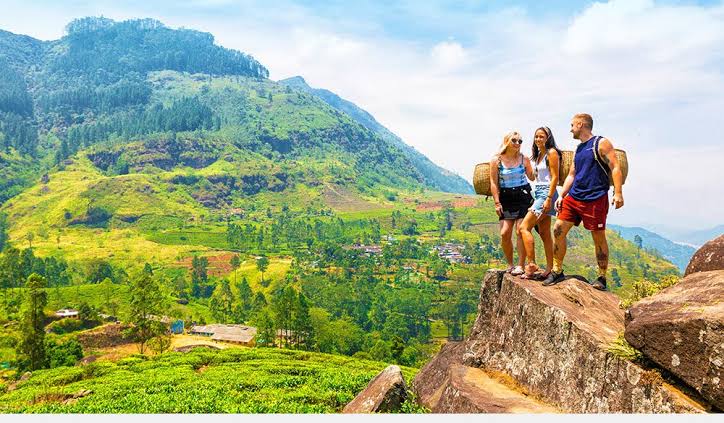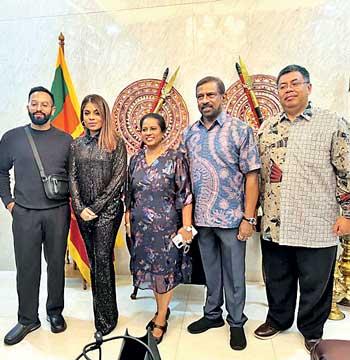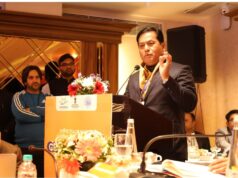Sri Lanka’s journey with Indonesia

Sri Lanka, nestled in the heart of the Indian Ocean, boasts of a rich tapestry of history, culture, and natural beauty. Positioned as a key nation in Southeast Asia, Sri Lanka is at a pivotal juncture for growth and development, drawing invaluable lessons from Indonesia’s dynamic trajectory.
Indonesia, a sprawling archipelago mirroring Sri Lanka in its diverse landscapes and cultural diversity, has earned a name for its economic resurgence. Navigating rapid growth, Indonesia has not only fostered economic vitality, but also cultivated societal cohesion through a deep respect for religious pluralism and cultural heritage.

meeting with Sri Lanka Ambasador to Indonesia Jayanath Colombage
For Sri Lanka, Indonesia’s success serves as a model worth embracing. The adoption of Indonesia’s inclusive economic policies could catalyse Sri Lanka’s own development aspirations. Furthermore, Indonesia’s steadfast commitment to upholding religious tolerance and honouring cultural identities underscore the importance of fostering harmony amidst diversity—a cornerstone for sustainable progress.
Sri Lanka is making significant strides in strengthening its economic ties within the South Asian region, focusing on finalising Preferential Trade Agreements (PTAs) with Indonesia. Historically oriented towards markets in the USA and Europe, Sri Lanka is now redirecting its attention towards the South Asian region as part of its broader ‘Look East’ strategy. This strategic shift aims to integrate more deeply into regional economic frameworks and bolster trade partnerships.
Indonesia, with its close ties to Sri Lanka, plays a pivotal role in this new economic strategy. As Sri Lanka endeavors to recover from an economic crisis, engaging with a rapidly developing nation like Indonesia becomes crucial. Indonesia is an archipelago nation consisting of over 17,000 islands, making it the largest island country in the world. Indonesia’s substantial population of 240 million and its goal to achieve developed status by 2045 present significant opportunities for bilateral trade and investment.
Historical connections
Sri Lanka and Indonesia share ancient historical ties, primarily through maritime trade routes that facilitated the exchange of goods, cultural practices, and ideas between the Sinhalese civilization in Sri Lanka and various Indonesian Kingdoms like Srivijaya and Majapahit.
Both countries have deep historical roots in Buddhism. Sri Lanka, a center of Theravada Buddhism, played a pivotal role in spreading Buddhism to Indonesia during the Srivijayan and Sailendra dynasties. This cultural exchange led to the establishment of Buddhist monasteries, stupas, and art forms in Indonesia, significantly influencing its cultural and religious landscape.
During the colonial era, both Sri Lanka and Indonesia were under Dutch rule, which shaped governance, architecture, and trade patterns in both regions.
To promote cultural exchange and enhance Indonesian tourism among Sri Lankans, the Embassy of the Republic of Indonesia in Colombo organised an official visit. Renowned Sri Lankan singer Umaria Sinhawansa and a delegation of journalists explored prominent Indonesian cities such as Jakarta, Bandung, Yogyakarta, and Bali. This initiative was supported by the Indonesian Ministry of Foreign Affairs, SriLankan Airlines, AirAsia and Garuda Indonesia.
Dive into diversity
Indonesia recognises over 700 languages and dialects, reflecting its incredible linguistic diversity. Bahasa Indonesia, the official language, serves as a unifying medium across the country, while regional languages like Javanese, Sundanese, Balinese, and many others are spoken widely.
Indonesian cuisine is a vibrant fusion of flavours influenced by various cultures, including Malay, Chinese, Indian, Arab, and European. Staple dishes like Nasi Goreng (fried rice), Satay (skewered and grilled meat), and Rendang (slow-cooked beef stew) are popular nationwide. Each region boasts of unique specialties; for instance, Padang food from Sumatra is renowned for its spicy and flavourful dishes, while Bali offers fresh seafood and aromatic spices.
Music in Indonesia reflects its cultural diversity and history. Traditional music includes gamelan orchestras, characterised by percussive instruments such as metallophones, gongs, and drums, often accompanied by traditional dance. Modern Indonesian music spans genres from pop and rock to traditional folk and dangdut, a popular genre influenced by Indian, Arabic, and Malay music. Gamelan music and angklung (bamboo musical instruments) performances are must-experience cultural treasures.
Visitors can explore Indonesia’s diverse cultural tapestry by visiting iconic landmarks like Borobudur Temple in Java, the majestic temples of Bali, and cultural centers in cities like Jakarta and Yogyakarta.
Jakarta
Jakarta, Indonesia’s capital, is a sprawling metropolis and the nation’s largest city. Serving as the political, economic, and cultural hub, Jakarta reflects Indonesia’s diversity and growth. The city hosts multinational corporations, financial institutions, and industries, driving Indonesia’s economic activities.
Jakarta has invested significantly in enhancing its transportation infrastructure to alleviate traffic congestion and improve connectivity. Projects include new roads, flyovers, and expansions in public transportation such as Light Rapid Transit (LRT), Mass Rapid Transit (MRT), and high-speed rail services.
The city is undergoing various urban renewal projects to modernise its infrastructure, including new commercial and residential developments, green spaces, and smart city initiatives.
Indonesia is shifting its capital from Jakarta to Nusantara, a planned city in East Kalimantan on the island of Borneo. This significant move aims to address multiple challenges faced by Jakarta, including severe overcrowding, traffic congestion, pollution, and the risk of flooding and land subsidence. Nusantara, is being built as a green and sustainable metropolis.
Borobudur Temple in Central Java
Indonesia’s cultural richness is exemplified by the Borobudur Temple in Central Java, a 9th-century Mahayana Buddhist temple complex and UNESCO World Heritage site. Constructed during the Sailendra dynasty, Borobudur combines Indonesian indigenous culture with Indian influences, featuring intricate relief panels and Buddha statues.
The temple, the world’s largest Buddhist monument, is constructed in the form of a stepped pyramid with nine stacked platforms, topped by a central dome. It showcases intricate relief panels and Buddha statues.
Built during the Sailendra dynasty, Borobudur reflects a blend of Indonesian indigenous culture and Indian influence.
Reconciliation efforts in Indonesia
Indonesia has made significant strides in reconciliation efforts following the Suharto era, focusing on human rights, inter-religious harmony, and decentralization of governance. The Istiqlal Mosque in Jakarta, Southeast Asia’s largest mosque, and the nearby Jakarta Cathedral symbolize Indonesia’s commitment to respecting diverse religious beliefs and promoting peaceful coexistence. Designed by Frederich Silaban, the Istiqlal mosque blends traditional Indonesian architectural styles with modern elements. It can accommodate 200,000 of worshipers.
Saung Udjo, Jl. Padasuka, Bandung
Saung Udjo is a cultural center located on Jl. Padasuka in Bandung, West Java. It is famous for its Angklung performances, a traditional Indonesian musical instrument made of bamboo. Visitors can enjoy cultural shows, workshops, and demonstrations. Around 500 students are studying there traditional Indonesian music.
Prambanan Temple compounds
Built in the 10th century, Prambanan Temple is the largest Hindu temple compound dedicated to Shiva in Indonesia. It features three temples rising above the center of concentric squares adorned with reliefs that depict the epic of the Ramayana. These temples are dedicated to the three principal Hindu deities: Shiva, Vishnu, and Brahma. Also, there are three temples dedicated to the animals who serve these deities.
The Prambanan Temple complex comprises a total of 240 temples. Situated on the border between the provinces of Yogyakarta and Central Java on Java Island, it stands as a monumental testament to Indonesia’s rich cultural and religious heritage.
Bali: Indonesia’s premier tourist destination
Bali, known as the “Island of the Gods,” boasts a vibrant and unique culture deeply rooted in Hindu traditions. Balinese culture is characterised by its religious ceremonies, traditional arts, and elaborate dance performances. The island’s Hindu heritage influences daily life, with offerings made to gods and spirits seen throughout the streets and temples.
Bali is renowned for its traditional arts, including intricate woodcarving, painting, batik fabric, and intricate silver jewelry. Balinese dance forms like the Barong dance and Legong dance are not just performances but also ritual offerings to deities.
Bali is a world-famous tourist destination known for its stunning beaches, rich cultural experiences and vibrant nightlife. The island attracts millions of visitors each year seeking relaxation, adventure, and cultural immersion.
Bali’s beaches offer diverse experiences, from surfing and diving spots in Kuta and Uluwatu to serene stretches of white sand in Nusa Dua and Sanur.
One of Bali’s iconic landmarks is the Garuda Wisnu Kencana statue (GWK statue), towering at 122 meters in the Garuda Wisnu Kencana Cultural Park, Bali, Indonesia.
Exploring these facets not only unveils the country’s diversity but also enriches one’s understanding of its people and their unique way of life.
Darshan Sanjeewa Balasuriya




